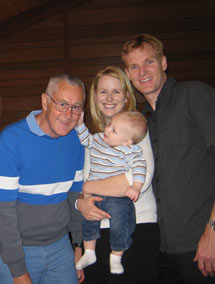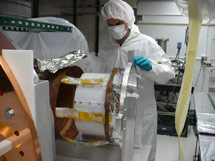
Handy Links
SLAC News Center
SLAC Today
- Subscribe
- Archives: Feb 2006-May 20, 2011
- Archives: May 23, 2011 and later
- Submit Feedback or Story Ideas
- About SLAC Today
SLAC News
Lab News
- Interactions
- Lightsources.org
- ILC NewsLine
- Int'l Science Grid This Week
- Fermilab Today
- Berkeley Lab News
- @brookhaven TODAY
- DOE Pulse
- CERN Courier
- DESY inForm
- US / LHC
SLAC Links
- Emergency
- Safety
- Policy Repository
- Site Entry Form

- Site Maps
- M & O Review
- Computing Status & Calendar
- SLAC Colloquium
- SLACspeak
- SLACspace
- SLAC Logo
- Café Menu
- Flea Market
- Web E-mail
- Marguerite Shuttle
- Discount Commuter Passes
-
Award Reporting Form
- SPIRES
- SciDoc
- Activity Groups
- Library
Stanford
Around the Bay
People: Like Father, Like Son
Knut Skarpaas VIII occupies the same SLAC office where his father, Knut Skarpaas VII, once worked. The Skarpaas bond runs deep; both father and son are passionate mechanical engineers who excel at extraordinary projects.
"I tend to have a more intricate, unusual style," said the younger Skarpaas. "Whereas my father built larger machines."
No kidding. Knut Skarpaas the Elder, who retired in 1993, helped design much of the 10,000-foot long accelerator structure for the SLAC linac. Hired on August 14, 1961—the same year that Congress authorized the accelerator—Knut Skarpaas VII was one of the not-yet-built laboratory's first employees.
"My father had been working at Hewlett-Packard until this point," said Skarpaas VIII. "SLAC promised him that he wouldn't have to wear a tie."
Skarpaas VII worked with the Hansen Experimental Physics Laboratory on the Stanford University campus, figuring out how to construct the accelerator beam pipe using thousands of small copper disks. The one-inch long cavities were designed to control the electrons "surfing" on the electromagnetic wave that makes the linac work.
Brazing the disks together in the required configuration and spacing was no easy task. The assembled sections, resembling a long metal roll of Life Savers candies, were connected into units 40 feet long. Flexible flanges were placed up and down the accelerator to hold the units together.
Each 40-foot section was laid underground and connected to waveguides to feed it electromagnetic waves from the Klystron Gallery. These waveguides are connected with patented "Skarpaas Flanges" that both maintain a vacuum and transfer microwave power to the accelerator. The end result: a mind-boggling object two miles long and four inches in diameter, down which atoms fly at nearly the speed of light.
Between all the super-science projects, the elder Skarpaas still found time to instill technical acumen into his son.
"When I was two or three years old, I got a toolbox, Erector set, and drafting machine," said Skarpaas No. 8. "My father told me, 'If you want a toy, make it yourself.'"
As a child, young Skarpaas constructed small cars and ships. When he was five years old, his father gave him his very first electric power tool, a jigsaw that he has kept to this day.
"I was the only child in my kindergarten class who knew how to draft," he said.
Skarpaas VIII graduated from California Polytechnic State University and worked as an engineer for a number of years before joining SLAC.
"Most of my life here has been ultra-low temperature, ultra-high vacuum, ultra-clean and ultra-precise," he said. His current work on the Enriched Xenon Observatory, an experiment built to observe a particle physics phenomenon called neutrino-less double beta decay in xenon gas, has posed some interesting and unique challenges.
Skarpaas had to design almost every component of the EXO detector to be machined from a single sheet of material that had been lying in a Canadian mine for years. This long-sheltered material was necessary since the experiment couldn't have any radioactive parts and all objects on the surface of the Earth become activated by cosmic rays and other sources.
Skarpaas also needed a special vacuum dewar to create a xenon ice crystal inside the detector. Ordering a custom-built unit would have been expensive and added months to the project. So Skarpaas went to Crate and Barrel, bought several inexpensive stainless steel drink shakers and had them welded together within days.
Given his background, it's no wonder that Skarpaas the Younger has such a flexible and particular engineering mind. He finds his parentage a blessing.
"I'm sometimes surprised to find that I'm working on the same stuff my dad did 40 years ago," he said.
The younger Skarpaas now has a legacy of his own; a seven-month-old boy named Knut Skarpaas IX. The infant Skarpaas' engineering training has already begun: his father recently gave him a plastic toy jigsaw.
—Adam Mann
SLAC Today, November 25, 2009

